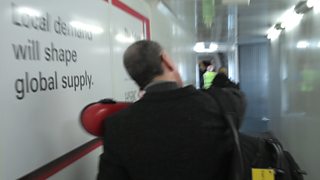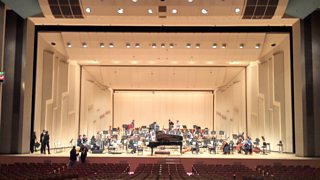Finishing what we started - The ������̳ Philharmonic in Japan
Julian Gregory
Violinist, ������̳ Philharmonic Orchestra
Tagged with:
In March of 2011, The ������̳ Philharmonic's concert tour of Japanese cities was curtailed by the earthquake and ensuing tsunami. There was nothing an orchestra could do to help; but, two years later, the band returned to finish the tour, fill in the gaps, and deliver a positive message.
Maybe this time they could do something.

Orchestra leader, Yuri Torchinsky, inadvertantly passes an advert that sums up the reason for our trip
What was the ������̳ Philharmonic doing in Japan anyway? Doesn’t Japan have their own orchestras?
Well, yes, they do; and very good ones too. But touring is an integral part of orchestral life; as a herd of unlikely diplomats we perform our peculiarly feisty British take on music across the world, saying 'hello' in the one true international language. Music is an intimate connection, and we like to say hello; audiences across the world like to say it back. The system works well.
That's what the ������̳ Philharmonic were up to on the 11th of March 2011, heading across Yokohama suspension bridge for the rehearsal to the evening show of , in three coaches, . Yokohama performed an enthusiastic parody of the , with us on it, and left the team of over one hundred musicians and organisers in no doubt that something profound had just happened. It had.
This is where the edit happens- we rehearsed for the concert, fearful, dazed and baffled, as the news rolled in of the disaster further North in . The concert was off, and, it slowly dawned, so was the tour, and the ������̳'s high risk unit rushed us home in one breath.
Two years passed, with a promise that we'd return and finish the job. Cue the edit … and suddenly , rehearsing the same programme, with the same conductor and soloist, for the same concert. 'Hey, we're puttin' the band back together!' The edit was seamless.
And so, with Yutaka Sado, inspiringly positive and smiliest
of conductors, and Nobuyuki Tsuji, the most exquisite and beautiful of piano
players, we were off, making our way across Japan, town by city; 12 concerts, 11
venues, 25 coach journeys, bullet trains at 165mph, queues at 0mph, and a total
audience of thousands. There was something significant to the Japanese people
about our return; we had a reason to do this tour and they understood that. The
tickets for each concert sold out a year ago, in 40 minutes or less. Is it
possible to feel more welcome?

Every concert began with a piece that wasn't printed in the programme, and each time Yutaka spoke to the audience about the reason for it; that we were about to say something to them, in memory of the tsunami victims. From the silence that followed his words, we began from Elgar's Enigma variations, and it wasn't so easy and straightforward as it is at the Proms. Why? Because, finally, we had a way to speak directly to the heart of the people, having experienced the unfolding disaster of 2011 and having retreated helplessly to the safety of home. The emotions felt on both sides were deep and lasting, and no-one escaped. Nimrod is noble and unsentimental, yet profound and personal, written by a friend for a friend. It was the right piece to play, and it set up the feel of the concerts; we were friends.
Japanese audiences are, as you might expect, technically the best in the world. Either they cough in the loud bits with great precision, or they are healthy beyond belief. They are perfectly quiet and focused- they don't drop programmes and their phones don't go off; they stay afterwards to applaud the stage hands as they de-rig, and they line up in the car park to wave the orchestra off in their coaches. They gasp in appreciation when the orchestra stands to take their applause, and they moisten up around the eyes at the appropriate moments in the music. Add to this the unspoken understanding of the reason for our visit, and you have no ordinary tour. The concerts were magic.
Our tour managers, Crystal Arts in Japan, ran the logistics with breathtaking efficiency. Despite the damage done by the earthquake, Japan still runs at a powerful and dynamic pace. But our hosts were not only efficient, they were generous, on one occasion unloading an entire symphony orchestra from three coaches into the bar featured in that famous fight sequence from Tarantino's Kill Bill, for a surreal experience involving seafood and Taittinger, but without the fighting.
This tour was business, with pleasure.
Every concert was a special event for us, and that's the glue that helps to keep an orchestra what it is; a unit of many different people pursuing a unified end. We don't produce anything you can use or even shake a stick at; our CDs and recordings are permanent, but what we really do is something you have to be there for. We can say 'hello' in any language you care to name, and we say it with one voice; in this visit to Japan we had something important to say, and I think we said it well. We were all touched in some way by the experience; one hardened pro observed that this tour had made him feel like a student again, and he wasn't alone. The connection between one island and another was bridged, like Yokohama and the world before the earthquake, by music, and the connection feels permanent.��
��
is a violinist in the ������̳ Philharmonic Orchestra.
- He also documented the orchestra’s tour to Japan on .
- Listen to .
- Find out more about the including .
- The ������̳ Philharmonic is also on Twitter - ��- and .
